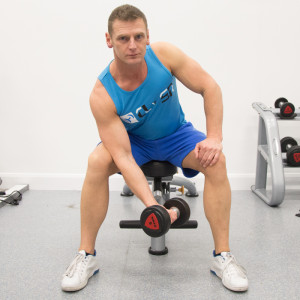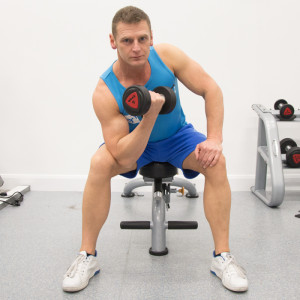Dumbbell Concentration Curl
Starting position:
- Sit at the end of flat exercise bench with feet flat on the floor, planted approximately 6 inches wider than shoulder width.
- Grasp a dumbbell with a closed, supinated grip (palms facing upward).
- Lean torso forward and position the back of your triceps (adjacent to the elbow area) against the inside of your thigh.
- Your free hand can rest on your other thigh or provide support behind the triceps of your working arm.
- Extend elbow of working arm, leaving a slight bend in elbow.
Upward movement/concentric phase:
- Flex the elbow, lifting the dumbbell towards your shoulder.
- Keep wrists straight throughout the exercise.
Downward movement/eccentric phase:
- In a controlled fashion, allow the elbow to extend back to the starting position.
- After the set is complete, repeat with opposite arm.
Exercise Data
FAQ'S & FACTS ABOUT Dumbbell Concentration Curl
What Is A Biceps Dumbbell Concentration Curl?
A concentration curl is a resistance exercise, which involves the primary elbow flexors, the brachialis and biceps brachii. This exercise is performed with a dumbbell, in a seated position, with the exercising arm supported on the inner thigh. This position allows the lifter to isolate the contraction of the biceps, one arm at a time, effectively. As the arms are turned inward to accommodate the positioning of the lift, the long head of the biceps brachii is activated. Placing tension on the long head of the biceps brachii complements overall hypertrophy of the biceps and helps develop the “peak” of the muscle.
The concentric portion of the lift is elbow flexion. The concentric portion involves the lifting of the weight. The eccentric portion is elbow extension, which involves the descent of the weight.
The purpose of the concentration curl is to strengthen the biceps while promoting hypertrophy (increases in size) of the biceps.
Why Do Biceps Dumbbell Concentration Curls?
When strategically implemented in an exercise regimen, concentration curls complement other biceps exercises, providing a change in grip and angle. This provides an advantage for optimizing the hypertrophy of the biceps. Elbow flexion performed in the concentration curl position, with rotation of the arm inward, activates the long head of the biceps brachii. In addition, concentration curls allow lifters to fully isolate elbow flexion, optimizing contraction of the biceps.
Concentration curls strengthen and increase the size of the biceps brachii, brachialis. Although it is primarily an exercise for aesthetics, concentration curls also serve as an auxiliary exercise that can increase strength involved in other multi-joint exercises.
Anatomy Of A Biceps Dumbbell Concentration Curl
The biceps brachii is located on the front of the arm, originating at the shoulder and inserting in the elbow joint. It consists of two heads, the long head (outer portion) and the short head (inner portion). The long head tendon helps stabilize the shoulder joint and its origin is located at the tubercle and lip of the glenoid cavity of the scapula (shoulder blade). The short head origin is located at the coracoid process of the scapula. The long and short head unite as the muscle bellies run down the front of the arm. Both heads merge, sharing insertion into the radial tuberosity of the elbow joint.
The biceps brachii flexes the elbow joint and supinates the forearm. Supination refers to the simultaneous rotation of the wrist and elbow as the palm of your hand faces upward. Both heads of the biceps flex the elbow joint together, however, positioning of the arm rotated inward elicits greater activation of the long head of the biceps brachii.
The brachialis lies underneath the biceps brachii, originating at the front of the lower end of the humerus bone. Its insertion is located at the coronoid process of the ulna at the elbow joint. The brachialis is a primary elbow flexor.
The brachioradialis aids the biceps brachii and brachialis during elbow flexion, helping stabilize the elbow joint.
Although their contribution is minimal, forearm muscles, palmaris longus, flexor carpi radialis, and pronator teres contribute as weak flexors of the elbow joint.
Variations Of A Biceps Dumbbell Concentration Curl
Standing dumbbell concentration curls.
How To Improve Your Biceps Dumbbell Concentration Curl
Concentration curls are implemented in a training program to improve biceps exercise performance and strength gains. Concentration curls provide a variation in angle that can result in optimal muscle activation that increases strength and hypertrophy of the biceps.
Emphasis on eccentric contractions, prolonging the eccentric portion of the contraction, may also be incorporated in a training program focused on increasing strength. This should be implemented accordingly and with adequate muscle recovery as eccentric contractions cause substantial damage to muscle tissue.
It’s important to note that your repetition and set volume will depend on your goals (e.g. strength, hypertrophy, muscular endurance). It is also important to allow adequate recovery days in between biceps training to allow muscles to repair.
Common Mistakes When Doing Biceps Dumbbell Concentration Curls
Returning the weight to starting position too quickly. Performing the eccentric portion of the lift ballistically (e.g. dropping the weight on the way down, extending the elbows quickly) and/or hyperextending the elbows can result in biceps tendon injuries.
Flexing and extending the neck during the exercise may result in injury.
Flexing and/or extending the wrists during elbow flexion and extension. The wrists are to remain straight throughout the full range of motion.
Injuries Or Ailments & Their Effects Regarding Biceps Dumbbell Concentration Curls
If proper technique is not adhered to (dropping the weight quickly instead of controlling the descent on the eccentric portion of the lift), the likelihood of biceps injury increases.
Although rare, biceps tendon rupture may occur if warm-up is not sufficient and/or if intensity (load) is increased inappropriately.
If proper recovery is not implemented between training days for optimal muscle repair of the biceps, the biceps tendon becomes inflamed. Without proper rest and treatment, the inflammation remains and results in biceps tendonitis.
Impingement syndrome and rotator cuff injuries, in general, are commonly associated with biceps tendonitis/biceps tendinosis. Therefore, it’s best to avoid biceps exercises when addressing impingement syndrome/rotator cuff injury unless advised by a physical therapist.





